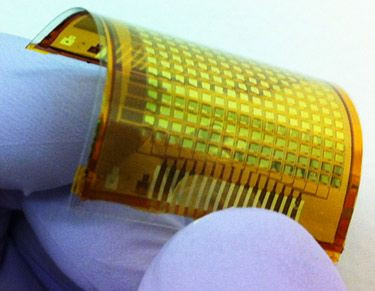E-Skin Imbues Robots With Sense Of Touch, And May Wallpaper The World With Touch-Screen Capability

The development of electronic skin, or "e-skin," brings the next milestone in the continuing symbiosis — and perhaps melding — of man and machine.
The thin new material may soon imbue robotics with a more sensitive touch while wallpapering much of the world with touch-screen capability.
"We are not just making devices," said Ali Javey, an associated professor of electrical engineering and computer sciences at the University of California at Berkeley, who led the work. "We are building systems."
Javey, who also works as a faculty scientist at the Lawrence Berkeley National Laboratory, received money for the work from the Pentagon's Defense Advanced Research Projects Agency as well as the U.S. Department of Energy.
"With the interactive e-skin, we have demonstrated an elegant system on plastic that can be wrapped around different objects to enable a new form of human-machine interfacing."
The e-skin responds to touch by emitting light, which brightens in correspondence with increasing pressure. Aside from obvious applications in humanoid robotics, the e-skin may allow various surfaces to function as touchscreen computer displays, such as vehicle dashboards and even the walls of a home.
Researcher Chuan Wang said the new device may serve important medical applications. "I could also imagine an e-skin bandage applied to an arm as a health monitor that continuously checks blood pressure and pulse rates."
Although it's easy to see entire walls covered in the material, the experimental samples developed by researchers measure 16-by-16 pixels, each containing a transistor, organic LED, and pressure sensor.
"Integrating sensors into a network is not new, but converting the data obtained into something interactive is the breakthrough," said Wang, who is now an assistant professor of electrical and computer engineering at Michigan State University. "And unlike the stiff touchscreens on iPhones, computer monitors and ATMs, the e-skin is flexible and can be easily laminated on any surface."
The flexible e-skin is comprised of a thin layer of polymer atop a silicon wafer. Researchers used off-shelf fabrication tools employed in the semiconductor industry to layer the electronic components after the polymer hardened on the silicon. Once the electronics were stacked, the researchers peeled the plastic from the silicon base, leaving a freestanding film with sensors embedded.
Javey said the process would be easy to replicate in mass-production. "The electronic components are all vertically integrated, which is a fairly sophisticated system to put onto a relatively cheap piece of plastic," he said. "What makes this technology potentially easy to commercialize is that the process meshes well with existing semiconductor machinery."
Now, Javey and company plan to incorporate senses beyond mere haptics into the skin, including the ability to respond to temperature and light.
Below is a video of the research:
Source: Wang C, Hwang D, Yu Z, et al. User-Interactive Electronic Skin For Instantaneous Pressure Visualization. Nature Materials. 2013.



























